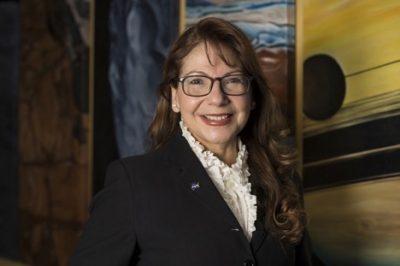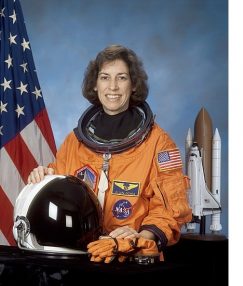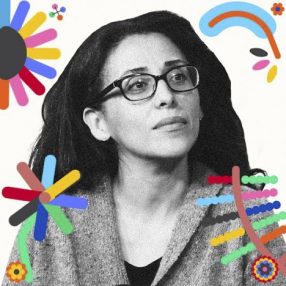October 16, 2023
Science, Y'all! celebrated Hispanic Heritage Month (9/15 - 10/15, 2023) by highlighting Hispanic geoscientists and providing links to related resources on our social media accounts. In case you missed them, we've compiled them here.
Happy #HispanicHeritageMonth! We are celebrating by highlighting some incredible Hispanic geoscientists and providing related resources. To begin, we want to shine the spotlight on planetary geologist, Dr. Adriana Ocampo.
Dr. Adriana Ocampo was born in Barranquilla, Colombia in 1955, and then moved to Buenos Aires, Argentina. Dr. Ocampo said that even as a child, she would go on the roof of her house to stargaze. She also said that she would play-create “spacecrafts” with pots and pans, and then dress herself up as an astronaut with her dog, Taurus, serving as her pretend co-pilot.
In 1970, when Dr. Ocampo was 14, her family moved to Pasadena, CA. In high school in Pasadena, Dr. Ocampo was able to participate in the Jet Propulsion Laboratory’s (JPL) Troop 509 and began to study physics and calculus. A couple of years later, Dr. Ocampo obtained a summer internship at JPL, during which she researched images taken by the Viking spacecraft.

She then began undergraduate study at Pasadena City College, where she studied aerospace engineering. Soon after starting, though, she transferred to California State University, changed her major, and graduated with a bachelor’s degree in geology in 1983. Upon her graduation, Dr. Ocampo took on a research scientist position at JPL. She went on to get her master’s degree from California State University, Northridge, in planetary geology and then a PhD from Vrije Universiteit in Amsterdam.
For her master’s thesis, Dr. Ocampo studied the Chicxulub impact crater. She and her colleagues found sinkholes and cenotes that were related to the crater. These findings were published in Nature in May 1991. She was also a leader in the discovery of ejecta lobes at the Chicxulub crater that were produced upon the asteroid impact during an expedition led by NASA and the Planetary Society Pasadena.
Throughout her career at JPL, Dr. Ocampo participated in a variety of projects. She aided in analyses of images from the Viking program to better understand Martian moons, Phobos and Deimos. She also led expeditions to another ejecta lobe site, a formation formed by the material that was ejected from a crater impact, in Belize associated with the Chicxulub crater, in addition to having led the near-infrared mapping spectrometer for the Galileo and Juno missions. In 2015, she was appointed the lead program executive for the New Frontiers Program, which includes the OSIRIS-Rex, New Horizons, and Juno missions.
Dr. Ocampo has received a number of awards for her excellence as a planetary geologist, including the Woman of the Year Award in Science from the Comisión Femenil, Advisory Council for Woman Award at JPL, and the Science and Technology Award from the Chicano Foundation. She was honored last year at the Latin America Lifetime Awards ceremony for her scientific contributions, and she also has an asteroid (177120 Ocampo Uría) named in her honor.
Read more about Dr. Adriana Ocampo here: https://solarsystem.nasa.gov/people/1780/adriana-ocampo/
Happy #HispanicHeritageMonth! Check out this piece by the USGS Coastal and Marine Hazards and Resources Program in which Alfredo Aretxabaleta, Claudia Flores, and Legna Torres-García discuss their backgrounds, research, and Hispanic heritage.
https://www.usgs.gov/programs/cmhrp/news/national-hispanic-american-heritage-month
To celebrate #HispanicHeritageMonth, we want to spotlight Dr. Ellen Ochoa, the first Hispanic female astronaut and a previous director of the Johnson Space Center!
Dr. Ochoa’s grandparents emigrated to Arizona from Sonora, MX. They later moved to CA, and Dr. Ochoa was raised in La Mesa as one of five children. She was a first-generation student at San Diego State University, from which she graduated in 1980 with a bachelor’s degree in physics.
Upon graduation, Dr. Ochoa began a graduate program at Stanford and received her master’s and doctoral degrees in Electrical Engineering in 1981 and 1985 respectively. Through her doctoral research, Dr. Ochoa developed highly specialized knowledge of optical systems for information processing. As Dr. Ochoa neared the completion of her doctoral degree, she witnessed Sally Ride go to space as the first female U.S. astronaut in 1983, which empowered and inspired her to apply for NASA’s astronaut program after completing her PhD.

Dr. Ochoa then obtained a position at Sandia National Laboratory in Albuquerque, NM to continue optical system research via the modeling and recording of planetary events. She transitioned to a position at NASA’s Ames Research Center, where she worked on computer systems intended for use on spacecrafts and rovers.
NASA selected Dr. Ochoa for the astronaut program in 1990, and she officially became an astronaut in July of 1991. As a crew member, Dr. Ochoa handled the computer hardware and flight software, and she eventually became the Deputy Chief of the Astronaut Office and Mission Control’s lead spacecraft communicator.
In 1993, Dr. Ochoa went on the Discovery spacecraft, which aimed to study the terrestrial ozone layer, and officially became the first Hispanic woman to go into space. She served almost 1000 hours in space aboard four space exploration missions. Dr. Ochoa played the flute on one of these missions to become the first astronaut to play an instrument in space!
From 2007-2013, Dr. Ellen Ochoa served as the Deputy Director of NASA’s Johnson Space Center—the first Hispanic director of the Johnson Space Center. Dr. Ochoa won NASA’s Distinguished Service Medal, Exceptional Service Medal, and Outstanding Leadership Model and was honored as a member of the United States Astronaut Hall of Fame.
Read more about Dr. Ellen Ochoa: https://lemelson.mit.edu/resources/ellen-ochoa
Happy #HispanicHeritageMonth! Today, we spotlight the work of climate scientist and activist Nicole Hernandez Hammer.
Nicole Hernandez Hammer was born in Guatemala, but her family moved to the United States when she was four years old and eventually put down roots in Florida. In 1992, Hernandez Hammer and her family lost their home in Miami due to Hurricane Andrew.
Motivated in part by her own experiences with natural disasters, as well as by her mother’s encouragement to protect the environment, Hernandez Hammer attended the University of South Florida to study integrated natural sciences. After obtaining her bachelor’s degree, she went on to earn a master’s degree in biology from Florida Atlantic University and an MBA from Palm Beach Atlantic University.

Hernandez Hammer researches sea level rise and the disproportionate impact of climate change on communities of color and of low-income. In particular, Hernandez Hammer has researched and communicated regarding the socioeconomic inequity and devastating impact of sea level rise on Latinx communities. She aided in the creation of the Climate Assessment of Southeast US to investigate the infrastructural consequences of sea level rise.
Hernandez Hammer’s thoughtful approach to the intersection of public outreach and demographic inequity has led to a high degree of public recognition for both her and her cause. Her research and outreach efforts have been written about in NPR, National Geographic, The New York Times, The Washington Post, and more. In 2015, Michelle Obama invited Hernandez Hammer to the State of the Union Address to discuss climate change and the communities that are most affected by it.
In addition to broadly educating the public about the uneven distribution of climate change impacts, Nicole Hernandez Hammer has worked to make climate change information more accessible. By working at the nonprofit Moms Clean Air Force, she created climate change outreach informational handouts in Spanish. With the Union of Concerned Scientists, Nicole Hernandez Hammer spearheaded efforts to create climate change adaptation programs that are accessible for all communities.
Read more about Nicole Hernandez Hammer and her research and activism: https://www.biohabitats.com/newsletter/inspiring-women-of-ecology/nicole-hernandez-hammer/
https://rock.geosociety.org/gsatoday/archive/24/1/pdf/i1052-5173-24-1-52.pdf
https://www.nasa.gov/sites/default/files/atoms/files/hispanic_astronauts_fs.pdf
https://earth.stanford.edu/news/qa-what-does-it-mean-be-latinx-geosciences
https://www.nasa.gov/centers/johnson/about/people/orgs/bios/ochoa.html
https://www.nasa.gov/wp-content/uploads/2016/01/chang-diaz_franklin_0.pdf
https://www.nsf.gov/nsb/members/past_members/cordova.jsp